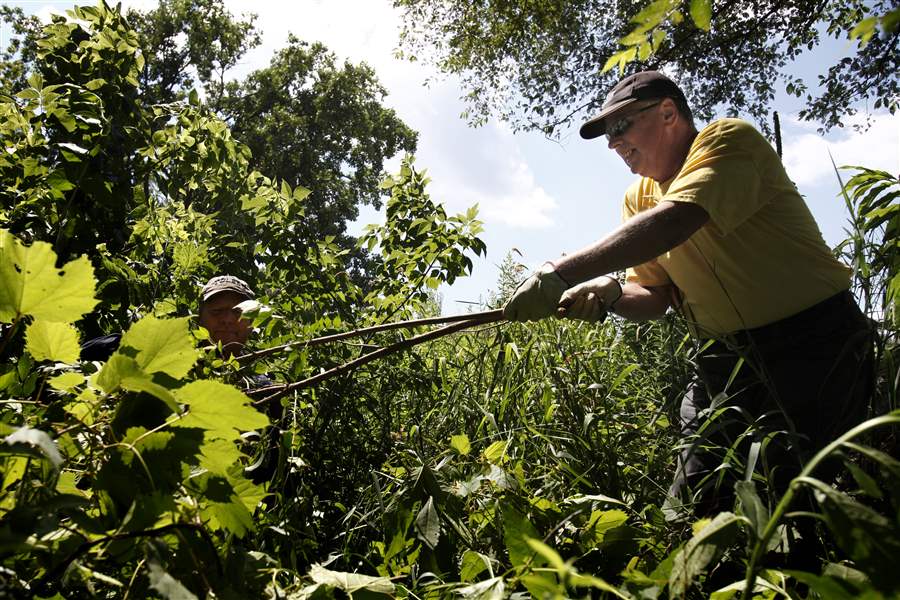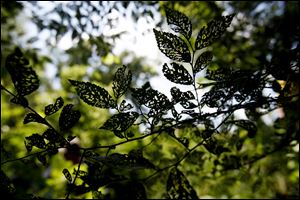
UT summer interns fighting against nature’s leafy invaders
7/13/2013
University of Toledo graduate student Mike Griswold removes invasive species on campus, along the Ottawa River. It’s part of a summer internship to clean up an estimated 1,000 acres of habitat.
THE BLADE/JEFFREY SMITH
Buy This Image

University of Toledo graduate student Mike Griswold removes invasive species on campus, along the Ottawa River. It’s part of a summer internship to clean up an estimated 1,000 acres of habitat.
Removing invasive plants from the University of Toledo campus has its challenges.
Just ask the four seasonal interns who spent this week there, working to remove aggressive, meddlesome plants such as the invasive form of honeysuckle and buckthorn. Mike Griswold, a graduate student at the university, said the interns have also all encountered another common intrusive plant — poison ivy.
“We’ve all suffered a little bit,” he said.
The work the interns will complete this summer is part of a grant that was secured by Partners for Clean Streams, a nonprofit organization that strives to improve water quality in northwest Ohio.
Awarded an $800,000 grant from the National Oceanic and Atmospheric Administration to focus on habitat restoration, the nonprofit hired eight Maumee Corps interns this summer to clean up an estimated 1,000 acres of habitat along the Ottawa River and Swan Creek watersheds.
The interns will also help with existing projects in the community through partnerships with other organizations, including Boy Scouts of America, The Nature Conservancy, Metroparks of the Toledo Area, and The Olander Park System. The other organizations have hired more employees, utilizing the grant funding.
With an eight-hour per day work shift, the interns spent much of this week removing branches and leaves.
A botanist surveyed the areas where they are removing invasive plants to determine which needed to be cleared away. The interns have also learned to identify plants. Other invasive plants they have cleared include burdock, teasel, and thistle.

An American elm tree with Dutch elm disease will be removed by summer interns.
Mr. Griswold said after clearing out the plants, the interns will return to the areas and plant native species plants that will help protect the watershed.
“We’re kind of creating more room for them to survive,” he said about the existing mature trees on the university’s campus.
“Some of the exotic species, they really just spread out,” he said, adding that when this happens, the plants can overtake others and grow out of control.
Kyle Spicer, project coordinator for Partners for Clean Streams, said removing the plants will help increase biodiversity and create a viewable place.
“The goal, too, is to allow the students of UT more visible access to the river,” he said.
Intern Scott Weis agreed that many plants were crowding out the view of the river on the campus.
“You forget there’s a river there,” said Mr. Weis, a former UT environmental science student.
While removing plants, the interns found something they just didn’t want to clear: A robin’s nest.
“We just couldn’t take it down,” Mr. Griswold said.